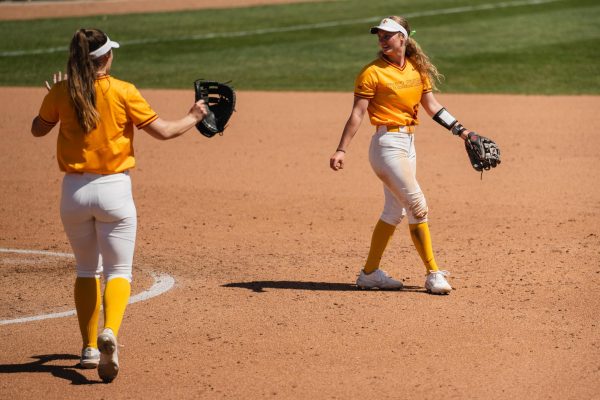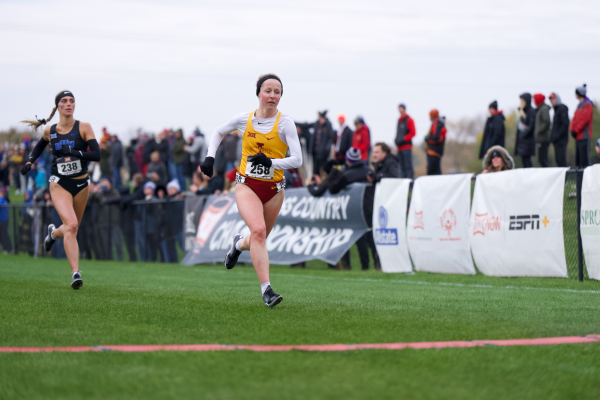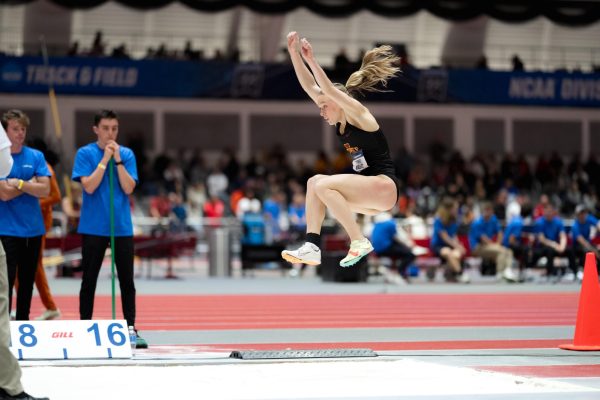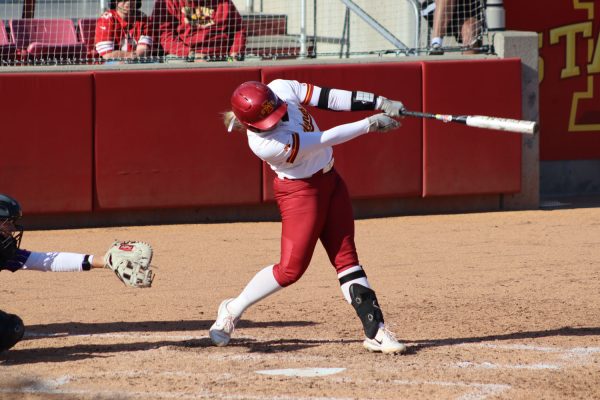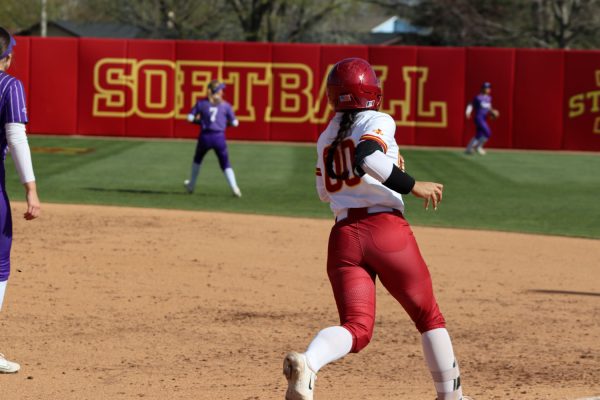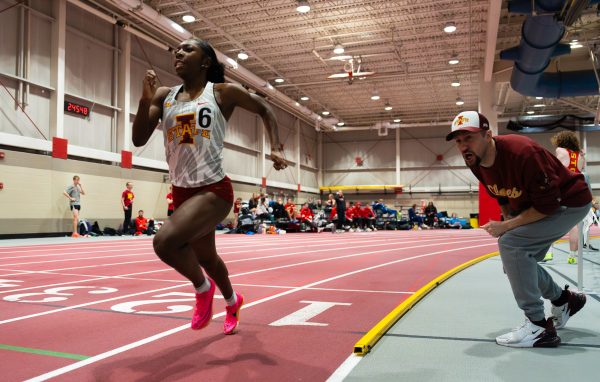Cyclones run in the spread
October 8, 2010
Chase Clement threw for 4119 yards in 2008.
This may not be a household name for Iowa State fans, but Clement was the quarterback at Rice University, where current ISU offensive coordinator Tom Herman used to set up shop. When coach Paul Rhoads arrived to Ames in the Spring of 2009, he brought Herman with him, and Herman’s idea of the spread offense.
More recognizable names like Sam Bradford (4720 yards), Chase Daniel (4335 yards) and Colt McCoy (3859 yards) made the Big 12 Conference known for the spread with monster passing numbers. There was no doubt that Herman and his inherited quarterback Austen Arnaud would leave burn marks in the Jack Trice turf and the Cyclone history books.
“There’s certain passing game gurus that may disagree with me, and obviously at Rice we were able to throw it a whole lot and win games, but I think in this conference and this day-and-age, you have to run it to win,” Herman said.
What happened to throwing it around the yard?
Opening the door
With recruiting and transfers in college football, new coaching staffs don’t necessarily have to make do with what they have or what they inherit. There is some leeway in schemes and units, but Rhoads’ staff didn’t necessarily have to do that. The Big 12 was set up for high-flying offenses, but the new coaching group just wanted to bring order to the chaos.
“We got here and we watched every game from the previous season, but it was a hodge-podge of offensive schemes that were kind of a week-to-week deal,” Herman said.
“One week they were in the I-formation a bunch, the next week they were in the shotgun, spread out a bunch. We didn’t really know what to expect, but the biggest indicator was those first few practices of spring ball.”
The first few practices for a new staff with their new talent becomes a try-out of sorts. Coordinators don’t come in with preconceived notions of attitude, or old starters or entitlement. The slate is clean, and the players know it could be their chance to shine and their chance to stand-out. Spread offense or not, Iowa State’s new army of polo shirts and headsets knew what they had.
“The first thing was that the offensive line grasped the concepts very very quickly. They understand the big picture of our run game and that was evident to begin with. And A-Rob really impressed us right off the get-go in spring ball,” Herman said.
A strong offensive line, and a quick running back entering his junior year with plenty of potential to grow within the offense? That sounds like something to build around.
The offensive line had a solid core with senior Reggie Stephens snapping the ball, and being flanked by younger teammates with solid work ethics and plenty of size. Alexander Robinson is listed as 5 feet 9 inches, 191 pounds, and while not Barry Sanders small, could hide behind the starting linemen that all hit the scales at 300 pounds.
Iowa State’s quarterbacks weren’t slouching while all this was going on. Then-junior Arnaud had visions of being a great passer with his name alongside Bradford, McCoy, Daniel and Kansas’ pint-sized signal caller Todd Reesing.
With injuries in the receiving corps, and success heading north-and-south, 2009 wouldn’t be Arnaud’s coming out party.
It wouldn’t need to be. Robinson ran for 1195 yards in 12 games, and caught three touchdowns in addition to the six he ran.
The rushing game and a solid defense were enough reason for the Cyclones to head to the post-season in Rhoads’ first year, but there had to be some fix for year two.
“We haven’t been able to throw the ball with any great effect, so teams have said ‘All right, throw it. We’re going to put everybody we can in here to stop the run,'” Rhoads said.
“You can have really good O-line, you can have really good schemes and you can have really good running backs, but if people say we’re going to be in here and we’re not going to give you that opportunity, and you can’t throw it effectively, it’s hard to have the success you need.”
A successful 180 yards on the ground per game in 2009 made Herman’s spread look more like the one West Virginia had run in recent years, than the pass dominated assaults that were make the Big 12 look like basketball teams on grass. It worked for the Cyclones in 2009. Why couldn’t it work in 2010?
“I think we’ve committed to it. From the day we got here it was very evident that it was going to be the strength of our team, was the offensive line, and we had a good tailback, now we’ve got a few good tailbacks,” Herman said.
“We had mobile quarterbacks. We certainly made that an emphasis understanding that it was already the inherited strength of our team.”
The Cyclones sit at 3-2 overall, and 1-1 in the Big 12 even though a 52-38 win over Texas Tech at home made the ISU fan base walk with a little hitch in its step.
The few good tailbacks help. Against Texas Tech, they all had major contributions. Iowa State hasn’t had a stable of backs capable of dominating a game in years. The fact that they’re doing all of this in the spread is just a testament to progress.
Like every good backfield, the offensive line is the immediate recipient of praise. But the running backs themselves bring different things to the table, and they’re all getting a chance to showcase their talents in different ways.
The laborers
Compact and tough, but aggressive and confident on the field, Robinson is a prototype running back. He’s got breakaway speed, even though he got caught on a 65-yard run with a sore ankle against Texas Tech. Robinson has 25 career touchdowns, and in his senior year, is considered something of a constant in this offense.
Statistically, he isn’t on pace to beat his own 2009. Robinson has more help in 2010, he can breathe, and he can lead and teach the group. He’s doing just that, focused like a 22-year-old coach.
“I think I said it from last year and from this preseason, the key is being consistent,” Robinson said after the Texas Tech win.
“I think you saw in that third quarter, lulls and things. We just can’t do that, we have to execute every drive.”
Robinson’s health is as constant a talking point as his success. He hasn’t missed substantial amounts of time at any point, but like any guy that runs into a mass of bodies and tacklers 20 times a game, he’s got bumps and bruises. His current ankle problems are a non-issue.
“It’s just sore. I played last game with it, I practiced all week with it, and I played this game with it. It’s not something that’s going to keep me out,” Robinson said.
Robinson’s absence against Nebraska was covered up by a miraculous eight-turnover game in 2009. He was banged up a little in 2008, but split carries throughout the season, and only hit 20 carries once.
Herman and Rhoads know now that with the trio of tailbacks they’ve got working the game, Robinson doesn’t need to be Earl Campbell. He just has to do what he can.
“It certainly takes a load off of A-Rob. It makes you not cringe when he’s banged up. It makes you confident that part of your game-plan is not just thrown out of the window,” Herman said.
Jeff Woody talks casually and free, like he’s done plenty more interviews about the running game than his 24 career carries would suggest. He’s been a popular local figure since he bullied central-Iowa defenses at Southeast Polk High School, and his playing time at Iowa State has gotten him plenty of Des Moines-based buzz.
Woody is a proud Cyclone, and with his easy demeanor, focused talking points and rugged style of running, is an Iowan in the spotlight. He’s a success story for all the local kids that think they’ll get lost in the recruiting process to faster and tougher kids in Texas and Florida.
But five games into the season, he’s also just a back-up running back trying to do his best to keep his playing time and help his team win, like the rest of his teammates.
“I think the neat situation that we’re in, is that the three guys that are taking all those reps, with A-Rob, and Jeff Woody, and Shontrelle Johnson, are all different kind of guys,” Herman said.
“The defenses may argue this, but coach Rhoads has often said that you get used to tackling one style of guy and the next thing you know another guy pops in there and its a different animal for those guys to tackle.”
Woody knows what he is. It isn’t to beat everyone on the field in a footrace, or to dance around and find a hole. The self-awareness and willingness to tighten his chin strap and bite down on his mouthpiece to get a first down mean the coaches have him out there for a good reason.
“If you would just say, this is a third-and-one, third-and-two, we need to drop the shoulder, and move somebody back and pick it up, Jeff Woody would be that guy,” Rhoads said.
He hasn’t punched the ball into the end-zone yet, but it seems like just a matter of time for the redshirt freshman. Like rushing in the spread offense, he focuses on what he can do well.
“We had two 60-yard runs, and that’s just straight speed from Shontrelle and A-Rob. I’ll just get you six and eight, and holes don’t have to be that big to make your own yards,” Woody said.
It isn’t of the quality of West Virginia’s Noel Devine, or even of the lightning quick Barry Sanders Jr., but Shontrelle Johnson has a YouTube highlight clip that got plenty of oohs and ahhs before the season even started. Featuring spin moves, running over defenders and speed to get around the corner at DeLand High School in the recruiting incubator of Florida, Johnson is a feature back. He’ll get his time, but he knows it just might not be immediately, and there’s plenty of time for the 18-year-old to learn.
“The attitude is just to approach practice and get better. I’ll go from there,” Johnson said.
His 61-yard touchdown scamper against Texas Tech was easily the longest run of his career, and helped put the freshman further than the 100-yard mark in just his fifth college game. Twelve carries, 102 yards and a touchdown in a backup role show the kid is deep threat, and like Woody, he just wants to make his coaches happy by focusing on what he does well.
“I believe in it, and I trust in my speed … it allows coaches to get a little more trust and confidence in me as far as my ability to make big time plays in big time games,” Johnson said.
The three backs got 12 runs a piece against Texas Tech. That they’ll be that balanced the rest of the year is doubtful, but it means running in the spread offense gives this team a good shot at success.
“It started with a philosophy. Being a defensive coach, and knowing that if you can run the ball you can do the other things that you need to do and want to. You can run time off on the clock, you can end games, things of that nature,” Rhoads said.
“The philosophy was there at the start. We just happen to have the personnel to allow us to do it effectively.”
Contemporary work
Funny thing is, Bradford, McCoy, Reesing, Daniel and Clement all graduated. The Big 12 has five quarterbacks in the nation’s top 35 in passing yardage per game, and two of them are running threats. Texas Tech’s Taylor Potts has had a coaching change, but is still throwing it around pretty efficiently even though his squad is struggling.
The Cyclones’ running game still isn’t in the top half of the country, even after the 250-yard outburst against Texas Tech. Good passing against Northern Illinois, the Hawkeyes’ fourth-ranked defense, and a rough offensive game against Northern Iowa are all reasons. There aren’t statistical parameters on running the ball in Herman’s offense, but the team will continue to work with the three backs that were successful last Saturday.
“Our breakdown on 1st-and-10 was high. I think it was something like 24-to-10, run to pass. It’s not like we were completely off our marker on what we were doing and when we were doing it, we just had enough success throwing it that they had to respect it,” Rhoads said.
Robinson was second in the Big 12 in rushing last year. Defenses definitely respect him. Arnaud is seasoned veteran behind center, and coaches around the conference have expressed their appreciation of his toughness and heart.
Johnson and Woody are the next backfield guys in line to earn that. Both in their first year of eligibility, they could theoretically be a duo for the next three years at Jack Trice.
In the second season of the spread, is it possible that the gunslingers have given way to smash-mouth football?
That’s a reach. The Cyclones are still throwing for more yards than they are running for on the season. Arnaud’s execution is a good reason for that. Consistency is a focus point for this team though, and the coaching staff feels the hard work shift the wind their way.
“We haven’t been very consistent, be it throughout a drive, or throughout a game, or from week to week. I’d like to believe that we’ve turned the corner, and that we understand that the way we practiced last week and the way that it carried over on to game day and the way we took the field and the energy that we had, translated into those points and that production,” Herman said.
The schedule is still tough. Utah, Oklahoma and Texas are still coming up. Utah brings to Ames the 11th-ranked rush defense in the country.
The Utes run their own variation of the spread offense. Utah has won nine straight bowl games with their attack — imitation would be the sincerest form of flattery.
“It’ll be challenging to say the least, because the team we’re playing is dang good,” Herman said.
“If we go out there and execute, I think we can play with anybody.”







